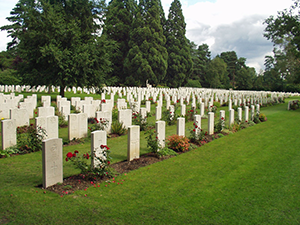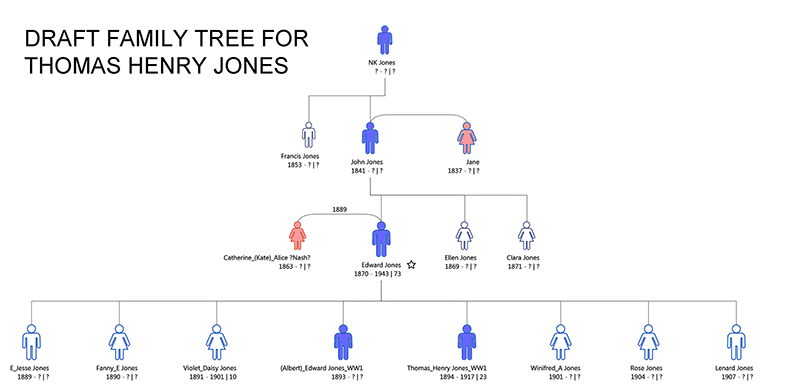First World War Project
Thomas Henry JONES (of Luddenham)
b. 1894 Private, Service Number G/18453 |

Thomas was one of eight children born to labourer Edward Jones and laundress Catherine (sometimes "Kate") (née Nash). He had three brothers - his older brothers were E. Jesse and (Albert) Edward and his younger brother was Lenard [sic]. His older three sisters were Fanny E. and Violet Daisy (who died at 10 years old). His two younger sisters were Winifred A. and Rose.
Before arriving at 6 Dent de Lion Cottage, Minster road, Westgate-on-Sea by 1911, Edward began life in Yalding (b. 1870); his wife, Catherine, hailed from Sevenoaks. After marriage in 1889, the family set up home in Southborough/Tunbridge Wells followed by a move to Five Oak Green/Tonbridge (Thomas's birthplace) where they remained until at least 1907 before moving to the Kent coast - Westgate on Sea and then Oare (No.2 Pheasant Cottages, Church Road), which is where our story begins. It is not clear why Thomas is remembered at Luddenham rather than Oare - perhaps his father or he had been employed on a Luddenham farm rather than Pheasant Farm, Oare?
It was his mother, Catherine, who was the sole legatee and arranged for the additional inscription - "Thy Will be Done" - to his gravestone. Catherine remained living at 2, Pheasant Cottages until her death (buried 13th April 1950, aged 86 years).
Thomas's headstone is one of more than 1,600 in the 500 acres that form the Brookwood Military Cemetery, the largest CWGC Cemetery in the UK. As a serviceman who died in a medical centre ("no longer physically fit for war service"), Thomas was awarded the Silver War Badge alongside the British War and Victory medals. Thomas died in "Brompton Hospital for Consumption and Diseases of the Chest" - established in 1855. Specialist Hospitals and Infirmaries became necessary as General hospitals feared infection of the larger patient body from Pulmonary Tuberculosis. By the time of the First World War, Brompton Hospital was at the forefront of treating tuberculosis. Although, at this time, there was no antibiotic treatment - the patients generally recovered, some died.
In 1918, the Chief Medical Officer's Report gives a sense of the circumstances facing Thomas.
"The number of "primary" cases of tuberculosis notified during 1917 (52 weeks) was 18,735, as compared with 17,631 in 1916 and 18,661 in 1915. Of these, 14,871 were pulmonary, and 3,864 other forms of tuberculosis, the corresponding figures in 1916 being 13, 547 and 4,084 respectively. These figures, differing from those given elsewhere in this report, include cases among soldiers and sailors.
The number of deaths from pulmonary tuberculosis in 1917 numbered 79 (48 males and 31 females). Other tubercular diseases caused 24 deaths, as against 12 in 1916, 17 being from tuberculous meningitis. Of the pulmonary tuberculosis cases ending fatally, 28 percent died in the Chelsea Infirmary and 40.5 per cent, in other public institutions; that is to say, 68.5 per cent, died away from the homes."
Military Experience of Thomas Henry Jones
Records associated with the Silver War Badge tell us that Thomas first enlisted on 31st May, 1915 soon after the 11th Battalion was first formed (5th May 1915). The Battalion was mobilised and landed in France on 3rd May 1916 - one year after Thomas enlisted.
Thomas was declared unfit for service on 14th August, 1917 when he was honourably discharged into the Brompton Hospital. This begs the question of when Thomas was first diagnosed. We don't have more detailed information as his personal military service records have not survived. The 11th Battalion, Queens Own Royal West Kent Regiment formed part of the 41st Division, 122nd Infantry Brigade.
So, Thomas may have seen action at: (1916) The Battle of Flers-Courcelette and of the Transloy Ridges; (1917) The Battle of Messines (7 June 1917 – 14 June 1917). It was only a few days after The Battle of Pilkem Ridge (31 July 1917 – 2 August 1917) that Thomas was discharged - he may well have been too ill to fight in this second battle of 1917.
The relevant War Diaries for Thomas tell us nothing about when Other Ranks were removed from the strength of their Battalion - news about officers is a bit more helpful but it may be a stretch to assume a link with Thomas.
One officer was 'struck off' the strength through sickness in the preceding six months. On 17th January, 2nd Lieut. H.W.H. BOTHAMLEY was remarked "sick to hospital". This suggests his return was expected. In contrast, some eight months later, on 29th August 1917, at HOLLEBEKE, Temporary 2nd Lieutenant G. RADCLYFFE "relinquished commission on account of ill-health and is struck off strength of Battalion." This is rather more definite! The reason is not mentioned. However, it may be just possible (at a stretch!) that the "ill-health" was shared with Thomas as they fought in the close confines of trench warfare.
Thomas Henry Jones was posthumously awarded the Silver War Badge, the Victory and British War Medals. [See Appendix 1]
Family of Thomas Henry Jones
Other Family Members and WW1
Thomas's brother, Albert, served in Royal Artillery (Royal Horse Artillery and Royal Field Artillery), Regimental Number, 48798. First signed up at the age of 19 for a "Short Service" in 1907 and finally discharged in 1918. Albert was a Fisherman out of Tunbridge Wells but by the close of his service, his mother is recorded at No.2 Pheasant Cottages, Church Road, Oare. He was employed in Railway Work in Baghdad, Basra and Bombay. He ranked as Assistant Quarter-Master Sergeant by 1917 and was in Basra again in 1918. Demobilised in Bombay on 4th June 1919. His only next of kin listed in his 22 pages of documents, other than his mother, is his brother "E. Jesse".


 World War 1 Pages
World War 1 Pages